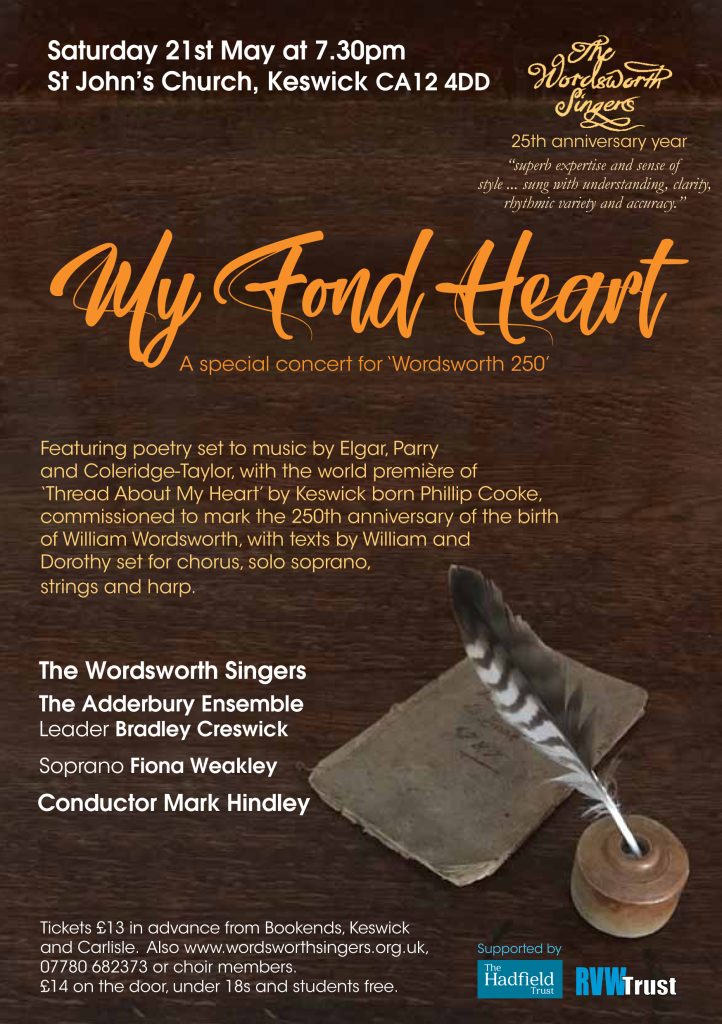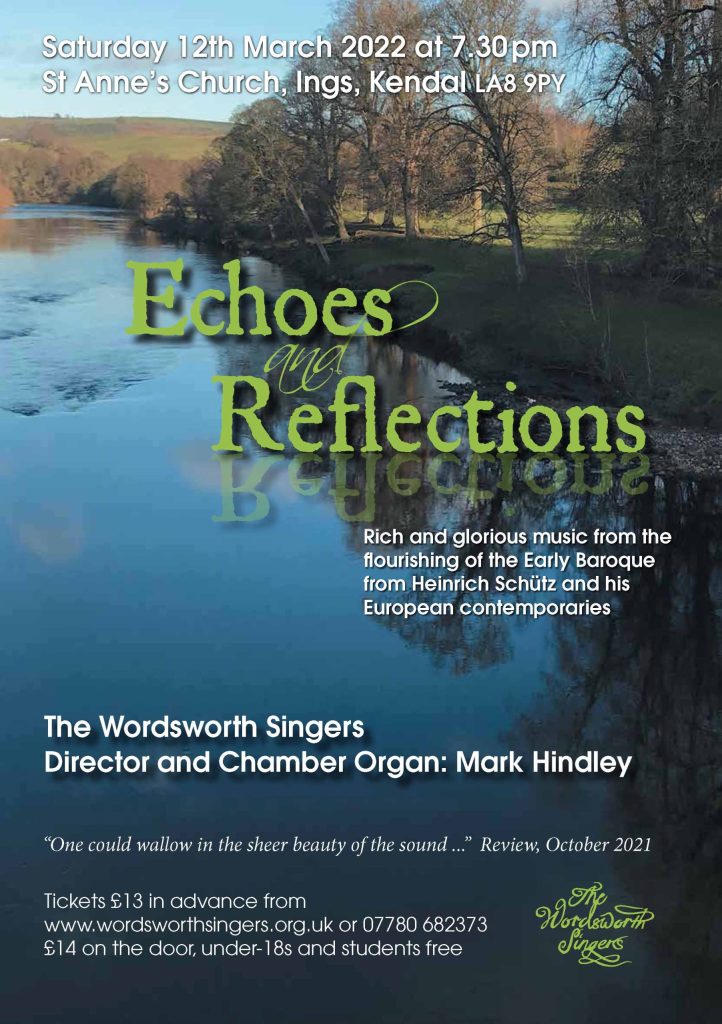
Night Flight & Serenade to Music – Lake District Summer Music Festival Concert
St Martin’s Church, Bowness
1st August 2022
After two years of pandemic-related uncertainty and caution, it was wonderful to see a full church on a busy holiday day in beautiful Bowness-on-Windermere for this early evening concert by Cumbria’s leading choir, The Wordsworth Singers. For although this concert was a celebration of Ralph Vaughan-Williams (in his 150th year) and festival composer-in-residence Cecilia McDowall, it was also a celebration of music-making and the power of communal singing and playing to an extremely high standing (no doubt Vaughan-Williams would have approved), something that has been denied to many in recent years.
The concert began with Vaughan Williams’ perennially popular late Three Shakespeare Songs, most well known for the opening setting of ‘Full fathom five’ from The Tempest, replete with chiming ‘ding-dong bells’ and mysterious harmonies. Conductor Mark Hindley kept the Prospero-induced enchantment in check and brought a measured conclusion to the Puckish pastoralism of ‘Over hill, over dale’, the final song in the set. This was followed by a world première from Cecilia McDowall, whose compositions are peppered throughout the festival from intimate songs to her wonderful work for tenor and chamber orchestra 70 Degrees Below Zero in the festival finale. Her work The Three Birds, a setting of a text by little-known poet Percy Stephen Beales, was quirky, playful and memorable, featuring some powerful singing from the choir’s basses as they represented an inscrutable God in this cheerful parable.
The entrance of cellist Francesca Cull (from the Odora Trio) to accompany the choir for the next two pieces changed the colour and atmosphere of the concert, firstly for the iridescent static ritualism of John Tavener’s Syvati and then McDowall’s celebration of nocturnal aviation NightFlight in which The Wordsworth Singers gave a compelling realisation of this dramatic piece. The concert finished with Vaughan Williams again, in his beautiful and rhapsodic paean to music itself, Serenade to Music which has become one of his most beloved works. The full Odoro Trio (with addition violist Eleanor Walton) joined the choir for a beguiling and bucolic rendition finishing a memorable concert in some style.
Phillip Cooke

St John’s Church, Keswick
What a privilege to be in the audience for this special concert to mark Wordsworth’s 250th anniversary at St John’s Church in Keswick. As the church filled, there was a palpable feeling of anticipation. The Wordsworth Singers did not disappoint. They were on top form; during the first half we were treated to some exquisite unaccompanied part-singing. From Elgar’s “Three Part-songs” to Parry’s “Six Modern Lyrics”, the choir showed their versatility from balance, enunciation and the most staggering dynamic range; ear splitting fortes to whispering pianissimos all seemed effortless. This range was expertly shown in a work with which I was not familiar, Samuel Coleridge-Taylor’s “Sea Drift” which was marvellously performed under the leadership of the choir’s director Mark Hindley. He is able to shape the choir’s sounds with minimal gesture and has them working as an entire unit. This was fresh and vibrant singing of the highest calibre.
During the second part, the choir were joined by The Adderbury Ensemble and soprano Julie Harvey. The first work was Elgar’s “Sospiri”, performed by harp and strings. There is a sad beauty about this work (written in 1914 and somewhat prophetic of the Great War) which was captured immediately in the translucent scoring and marvellous playing. What wonderful harp playing with a divine moment when the violins play sul G (high up on the lowest string of the instrument) The stillness at the end of this five minute work was deafening and shows Mark Hindley to be much more than choirmaster.
And so to the main work in this programme. Phillip A Cooke’s “Thread About My Heart” was commissioned by The Wordsworth Singers to celebrate Wordsworth’s 250th anniversary and this was its première. Phillip, who grew up in Keswick, was in the audience. To quote Britten on hearing Frank Bridge’s “The Sea”, this work knocked me sideways! I must admit I was sceptical about settings of Wordsworth and even more so extracts of Dorothy Wordsworth’s journals, indeed the composer himself had some doubts when he set to work, by his own admission. No such doubts were founded. His setting here, is exquisite, the sound-world vivid and imaginative. Phillip is truly founded in the British choral tradition, but his music is more than that. His use of ensemble is very clever indeed, weaving the choir and ensemble together to mirror the juxtaposition of the Wordsworth siblings’ texts. Phillip cast the work in seven movements; there are three Interludes which he sets words from Dorothy Wordsworth’s journals. These seem to refresh the ear and are transparently scored for harp, solo viola and soprano. Julie Harvey sang beautifully and again echoed the choir’s dynamic range and purity of sound. William Wordsworth’s poetic utterances were written for the full ensemble. Much of the thematic material was derived from a very arresting “romance” at the outset. These movements were followed by a “pastoral” a “nocturne” and a “hymn”; in each one Phillip showed his versatility as a composer, sometimes dark, sometimes witty, but never bland. His music is a direct communication with both performer and listener. It is modern, but approachable and highly intelligent; it is a breath of fresh air. The tremendous and warm ovation for both performers and composer spoke for itself. And, as the last words “peace, peace, peace” were sung they seemed, for one perfect moment, to echo the fading crepuscular light through the beautiful stained glass windows of St John’s.
© Philip Wood, May 2022.

St Anne’s Church, Ings
Mark Hindley brought his Wordsworth Singers to the tiny church at Ings. This is a little church with a big heart. It doesn’t offer a great mass of audience seating but those who do manage to get in find themselves in a warm, friendly and intimate concert space the acoustics of which are ideal for an a capella group. It may lack the huge space and the ‘sound of stone’ for which much of the music of the 17th century was written, but for modern concert performance purposes it also lacks the excessive reverberation and echo that are so often a feature of the larger spaces and which can be difficult for audience and performers alike. It allows expert ensembles such as The Wordsworth Singers to perform with great clarity the complicated rhythmic structures of some of the music of this period; detail which is so often lost in a larger acoustic.
Mark Hindley himself conducted throughout with an obvious absorption in the music and a confidence in his singers which in its turn was reflected in the enjoyment of the singers in what they were doing and their own confidence in performance. Several of the pieces Mark conducted from the keyboard of a chamber organ, relying on the singers to respond to head movements and no doubt facial expressions (unseen by the audience of course!) which they did superbly well. The 24 singers of this particular small ensemble, despite their numerical imbalance (17 women and 7 men), produced a well-balanced and robust sound that was thoroughly enjoyed by all present.
To put Heinrich Schütz in context it is interesting to note that he was born in 1585, just 100 years before Bach. He lived, for those early times, a very long life of 86 years, dying 350 years ago in 1672 and it would still be another dozen or more years before Bach was born. The programme for this concert explored just a few examples out of the colossal list of works by Schütz, together with some of his contemporaries.
In the first half we heard five pieces by Schütz and two by his friend Johann Hermann Schein. Schein was obviously much influenced by Schütz. So much so that one can detect Schütz ‘fingerprints’ in many parts of Schein’s work. It’s hard to tell which is which sometimes. By way of contrast in the middle of the first half we had a soprano duet by the only English composer of the evening. A setting of Duo Seraphim by Richard Dering with many echoes of the tenor duet in the Monteverdi Vespers using the same text. This piece was beautifully sung by Ann Bruce and Fiona Weakley; an extremely well-matched and well-balanced performance.
All the ensemble pieces by Schütz and Schein were performed with The Wordsworth Singers’ superb expertise and sense of style. They handled the many decorative flourishes and embellishments with great clarity. Music of this period is not over-endowed with original indications of dynamic variation, to say the least. For modern concert performance some rhythmic and dynamic variation is needed and it is up to the performers to provide it as they think fit. In some performances all too often one is presented with a solid mezzo-forte throughout. Not so here. Mark Hindley found many opportunities for quiet and delicate singing. In the original score there will be little or nothing from Schütz himself to help. Mark and the choir handled all the changes of rhythm, time signature and tempo with great skill.
The second half consisted of one single work by the Italian composer Gregorio Allegri. Many people will have heard his Miserere, a setting of Psalm 51, with its high Cs (which Allegri never wrote), and many of those people will be unaware of any other work by Allegri. This is a full Mass setting, one of five masses by this composer. No-one knows why he based it on a secular madrigal, but it is a firmly liturgical work of the traditional six sections and sung, like everything else in this superb evening of 17th century choral music, with understanding, clarity, rhythmic variety and accuracy.
What a delightful evening.
Jolyon Dodgson

St John’s Church, Keswick
After an enforced absence of almost two years, due to Covid-19, the Wordsworth Singers made a very welcome and impressive return to the concert platform last Saturday at St. John’s Church in Keswick. Though we might have expected the director, Mark Hindley, to ease his 30 singers in gently he challenged them with a programme of entirely unaccompanied, extremely complex music of the sixteenth and late nineteenth and early 20th century, some of it being in as many as eight parts. This was music that only the best of our cathedral and collegiate choirs would tackle and it was a great privilege for those in the audience to hear this music performed live by such an accomplished choir.
It is not without justification that the Elizabethan Renaissance is often referred to as the Golden age of English music and the first half of the concert was devoted to words by two composers of this period, William Byrd and Robert White. Byrd’s Laudibus in sanctis and Haec dies contain many of the elements of his complicated polyphonic vocal lines, tricky rhythms and changes of metre. The Wordsworth Singers managed all of this with assurance but what for me was the highlight of these three pieces was the almost magical performance of Byrd’s Ave verum corpus; beautifully phrased and with such an evenness of tone one could wallow in the sheer beauty of the sound. Although born around the same time as Byrd, Robert White died of the plague 49 years before his more illustrious contemporary and there is therefore a different feel to his music. The Lamentations of Jeremiah are a tour de force for any choir. The whole work lasts over 20 minutes during which the singers must sustain long unaccompanied vocal lines, often using a single vowel sound for many bars. Tuning, maintaining concentration and balance in this music is extremely difficult and it was very impressive hearing the Wordsworth Singers rise to this challenge with such conviction.
In the second half of the concert we jumped from the 16th to the late 19th century to the music of Stanford and Parry. The Three Latin Motets written for Alan Gray at Trinity College are frequently performed anthems in Cathedrals but it was a real joy to hear them as a group. All are very different and give scope for the musical director to shape the music as they wish. The rich sonority of Justorum animae gave way to the exciting eight part Coelos ascendit and was followed by the almost ethereal Beati quorum via. The choir were obviously back in their comfort zone and displayed all the choral expertise which makes them such a fine group. Stanford’s double-choir Latin Magnificat written for his friend C.H.H. Parry has all the hall-marks of a Bach motet, in fact one could call it a pastiche. This was given an exuberant and thrilling performance with sparkling clarity from the voices. This wonderful concert was brought to a fitting close with Stanford’s composition pupil Gustav Holst’s eight part Latin Nunc Dimittis, another memorable performance with a rich variety of choral textures.
The obvious joy of the singers to be able to sing again after such a long time was palpable and the audience responded with equally enthusiastic applause.
John Cooper Green
